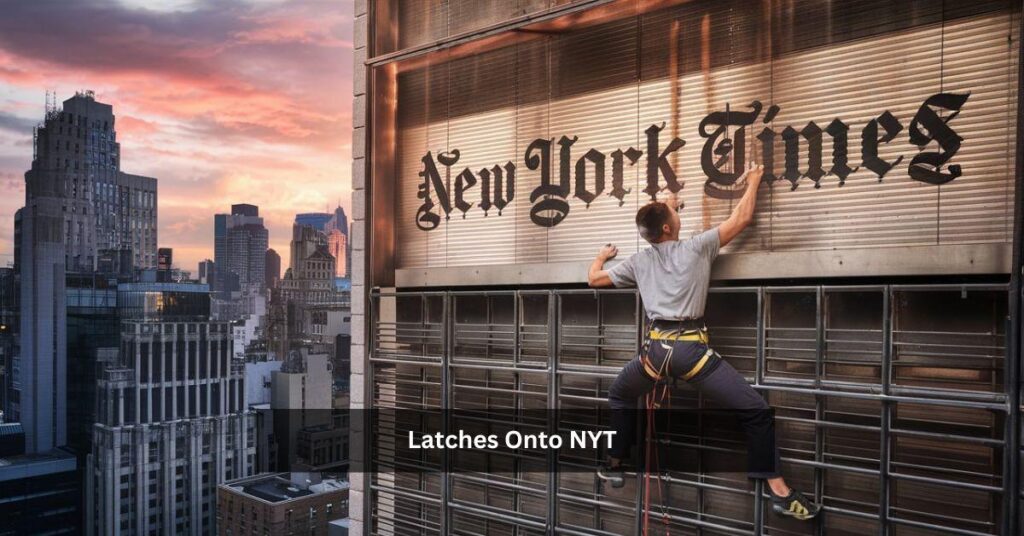The Evolution and Impact of Latches Onto NYT: A Comprehensive Exploration

Introduction
In today’s fast-paced digital age, news consumption has evolved dramatically, with new platforms and technologies shaping how we access and engage with information. One intriguing aspect of this evolution is the concept of “latches,” or the way certain ideas, trends, and stories “latch on” to prominent media outlets like The New York Times (NYT). This phenomenon reflects not only the changing landscape of journalism but also the broader cultural shifts influencing media consumption. This article delves into how latches onto NYT function, their implications for both the media and the public, and the broader context within which these dynamics occur.
Understanding the Concept of Latches
The term “latch” in this context refers to how certain ideas, trends, or stories gain traction and become prominently featured in influential media outlets such as the NYT. This process can be seen as a form of media amplification, where particular topics gain visibility and influence due to their alignment with current trends, societal interests, or newsworthiness.
Mechanisms of Latches Onto NYT
Relevance and Timeliness: One of the primary factors influencing whether a story Latches Onto NYT is its relevance and timeliness. Stories that align with current events, societal concerns, or trending topics are more likely to be picked up by major media outlets. For example, during times of political upheaval, stories related to policy changes or political figures are more likely to receive extensive coverage.
Public Interest and Engagement: The NYT, like other major media outlets, often features stories that resonate with a broad audience. Topics that generate significant public interest and engagement, whether through social media buzz, online searches, or public discourse, are more likely to latch onto the NYT. This is reflected in the media’s focus on stories that spark conversations and debates among readers.
Influence of Social Media: Social media platforms play a crucial role in determining which stories gain traction. Viral content and trending topics on social media often catch the attention of traditional media outlets, including the NYT. The interplay between social media and traditional journalism has led to a dynamic where stories that perform well online are more likely to be covered by major news organizations.
Editorial Decisions and Newsroom Priorities: Editorial decisions and newsroom priorities also influence which stories Latches Onto NYT. Editors and journalists make decisions based on factors such as newsworthiness, impact, and alignment with the publication’s editorial stance. This internal decision-making process determines which stories are highlighted and how they are framed.
Case Studies of Stories That Latches Onto NYT

To understand how Latches Onto NYT work in practice, it is helpful to examine specific case studies of stories that have gained prominence in the publication:
Political Developments: Stories related to major political events or figures often latch onto the NYT due to their significance and impact. For instance, coverage of presidential elections, significant policy changes, or political scandals frequently garners extensive attention. The NYT’s in-depth reporting and analysis of such stories reflect their importance and influence on public discourse.
Cultural Phenomena: Cultural phenomena, such as trending social movements or popular entertainment, also have the potential to Latches Onto NYT. For example, stories about movements like #MeToo or high-profile entertainment events often receive coverage due to their cultural relevance and the widespread public interest they generate.
Scientific and Technological Advances: Breakthroughs in science and technology can capture significant media attention, especially when they have broad implications for society. The NYT’s coverage of topics such as climate change, medical innovations, or technological advancements illustrates how these stories latch onto the publication due to their relevance and impact.
Human Interest Stories: Human interest stories that evoke strong emotional responses or highlight compelling personal narratives can also Latches Onto NYT. Stories about individuals overcoming challenges, acts of heroism, or unique experiences resonate with readers and often receive prominent coverage.
Implications for Media and Public Discourse

The process of Latches Onto NYT has several implications for both media and public discourse:
Shaping Public Perception: The stories that Latches Onto NYT have the power to shape public perception and influence societal attitudes. By amplifying certain topics, the NYT helps define the public agenda and highlight issues of importance. This influence extends to how readers perceive and engage with the news.
Impact on Journalism: The phenomenon of latching onto major media outlets reflects broader trends in journalism, including the emphasis on sensationalism, timeliness, and audience engagement. The NYT’s coverage decisions are influenced by these factors, which can impact the depth and breadth of reporting on various issues.
Feedback Loop with Social Media: The interaction between traditional media and social media creates a feedback loop where stories that gain traction online are more likely to be covered by major news organizations. This dynamic can amplify certain narratives and influence how news is presented and consumed.
Diversity of Coverage: The stories that Latches Onto NYT can also impact the diversity of coverage. While major stories receive extensive attention, smaller or less mainstream topics may be overshadowed. This can affect the range of perspectives and issues represented in media coverage.
Challenges and Criticisms

The process of latching onto major media outlets like the NYT is not without its challenges and criticisms:
Media Bias and Selectivity: The selection of stories for coverage can reflect biases and editorial priorities. Critics argue that the focus on certain stories may lead to selective reporting and a lack of diversity in the topics covered. The NYT’s editorial decisions are influenced by various factors, including audience preferences and institutional values.
Sensationalism and Clickbait: The emphasis on stories that generate high engagement can sometimes lead to sensationalism and clickbait. This approach prioritizes attention-grabbing headlines and narratives, potentially at the expense of nuanced and balanced reporting.
Impact on Journalistic Integrity: The pressure to attract readership and generate engagement can impact journalistic integrity. The NYT, like other media outlets, faces the challenge of balancing the need for compelling content with the commitment to accurate and responsible reporting.
The Future of Latches and Media Consumption
As media consumption continues to evolve, the dynamics of latching onto major outlets like the NYT are likely to change:
Digital Transformation: The ongoing digital transformation of media is reshaping how stories are disseminated and consumed. The rise of digital platforms, including social media and news apps, will continue to influence which stories gain traction and how they are covered.
Changing Reader Preferences: Reader preferences and behaviors are evolving, with a growing emphasis on personalized content and interactive experiences. Media outlets, including the NYT, will need to adapt to these changes while maintaining journalistic standards.
Emergence of New Media Models: The emergence of new media models, including independent journalism and niche publications, may impact the traditional dynamics of latching onto major outlets. These models can offer alternative perspectives and coverage, diversifying the media landscape.
Ethical Considerations: The ethical considerations surrounding media coverage and the selection of stories will remain a key focus. Ensuring accuracy, balance, and fairness in reporting will be crucial as media outlets navigate the complexities of a rapidly changing landscape.
Conclusion
The phenomenon of Latches Onto NYT represents a significant aspect of contemporary media dynamics. It reflects how certain ideas, trends, and stories gain prominence in influential media outlets and shape public discourse. The NYT’s coverage of these stories highlights their relevance and impact, while also illustrating broader trends in journalism and media consumption.
Understanding the mechanisms and implications of latching onto major media outlets provides valuable insights into the evolving landscape of news and information. As media continues to transform, the interplay between traditional journalism and digital platforms will shape the future of how stories are selected, presented, and consumed. For readers and media professionals alike, recognizing the factors that influence media coverage and engagement is essential for navigating the complexities of the modern media environment.


Leave a Comment